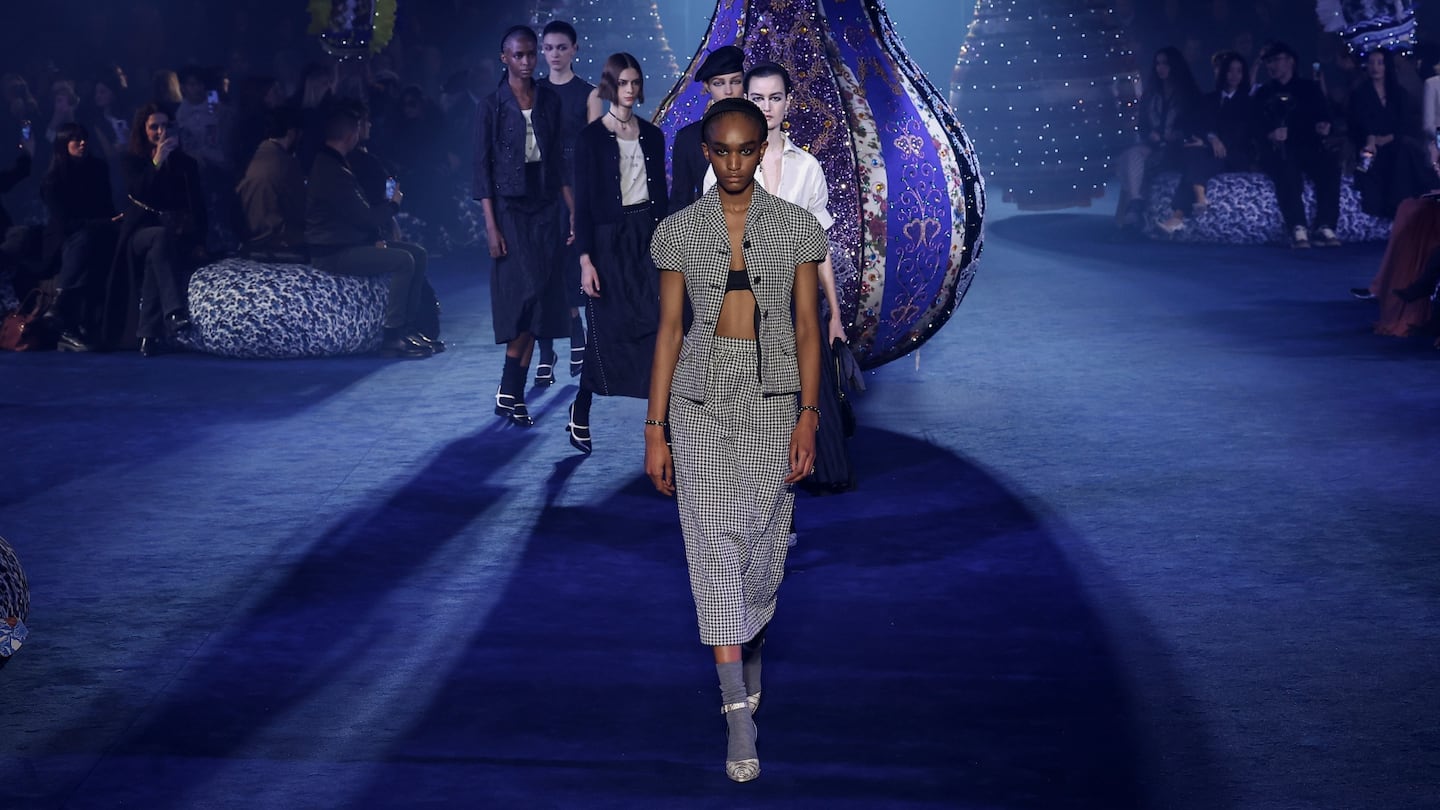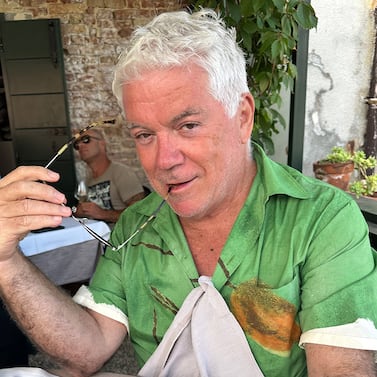
The Business of Fashion
Agenda-setting intelligence, analysis and advice for the global fashion community.

Agenda-setting intelligence, analysis and advice for the global fashion community.

PARIS — Far be it from me to analyse a designer’s psychological state, but it did seem to me that both Maria Grazia Chiuri at Dior and Anthony Vaccarello at Saint Laurent were responding to a darkening world in their latest collections. Consider them as coping strategies. That certainly added a different weight to the work.
Chiuri’s focus was Paris in the 1950s, not a Technicolor Audrey Hepburn popping down to a boho Left Bank jazz club in “Funny Face,” like Hollywood wanted us to see, but the black and white postwar city of the existentialists (or the neo-realists, in Chiuri’s Italy). When she dug in the Dior archives, she saw how the initial burst of New Look optimism contracted to dark, edgy monochrome, almost like the punk of its time. She found human co-relatives in the beatnik chanteuse Juliette Gréco (a Dior client) and Édith Piaf, the iconic “Little Sparrow” whose fearlessness and unpredictability made her the French equivalent of Judy Garland. Completing Chiuri’s trio of inspiratrices was Christian Dior’s sister Catherine, French Resistance fighter and concentration camp survivor, who found succour in her postwar success as a florist.
These resilient women struggled, suffered and survived, or not — just as millions of women are doing right now — and Chiuri showed a huge collection of clothes that reflected all that. There was too much, but maybe that was the point. As the looks passed by in steady procession, their somber beauty became a curious balm for the soul, and the details began to assert themselves: the way the back of a jacket floated away from the body, the crop of a peacoat, a strangely appealing embroidered leather harness, a shrunken argyle-patterned mohair sweater and a skirt in chiné a la branche (the blurred, shimmery floral effect that was once the province of silk weavers in 18th century Lyon), the coronets of gilded straw and dried flowers worn by the models in the finale… and, most of all, the crinkled fit and flare of clothes woven with metallic thread, so the pieces retained a kind of memory. They looked exhausted but elegant, like old favourites treasured in hard times. And, because this is Dior, after all, the fabrics were fine reworkings of the moiré, the duchesse satin, the pied de poule that were Christian’s original stock in trade.
Chiuri felt it was the most French collection she’d done since starting at Dior seven years ago, but also the most Italian in its precise construction. She also said her artist outreach this time, Joana Vasconcelos from Portugal, had come closer to her own process than any of her other collaborators, with a studio that was like a fashion atelier. The show took place in a huge visceral cocoon, a kind of magic garden created by Vasconcelos from floral-patterned fabrics in the Dior archives. It was her tribute to Catherine Dior, whom flowers saved from a living hell. It was also one more testament to the lavish scenarios that Bernard Arnault’s bottomless pockets are capable of underwriting, hard times be damned. Piaf’s tremulous tones rang out at show’s end. “Moi, je ne regrette rien.” Indeed.
ADVERTISEMENT
0 of 95
I could say exactly the same thing about Saint Laurent. The very first fashion show I ever saw in Paris was a YSL couture show in 1987, in the ballroom of the Hotel Intercontinental. (I’ll always remember it as the day I met Nan Kempner.) Walking into Saint Laurent’s usual venue on Tuesday night, a pharaonic tent constructed within cooee of the Eiffel Tower, I was overpowered by déjà vu. The low catwalk lit by a string of massive gilt chandeliers was Intercontinental Redux. Saint Laurent’s maestro-in-residence Anthony Vaccarello insisted he wanted something more intimate after last season’s epic reel around the fountain, but intimacy is clearly a moveable feast when the billions of today’s fashion tycoons start their lubricating churn.
And, actually, Saint Laurent’s spectacular mise-en-scene did make a rather interesting point. Saint Laurent is no longer just a name or a look. It is also emblematic of a time, a place, the Intercontinental ballroom in 1987, for instance. It’s a piece of history. Maria Grazia Chiuri acknowledged as much for Dior, when she talked about the vintage map of Paris she used as a scarf print this season. She marvelled at the fact that Christian Dior’s couture salon on Avenue Montaigne was included on the map alongside the museums and monuments that have always defined the city in the eyes of the world.
If the collection Vaccarello presented didn’t exactly make any more history, it was a more tangible acknowledgment of the moment than he’s shown lately. As is his wont, he elaborated on one message throughout the show, which could be broadly summed up as power dressing. He listed the components: minimal, classic, pure, basic clothes, a reaction to last season’s monumentalism. “No tra-la-la, no trick of styling.”
The models’ hair was styled uniformly tight. They all wore aviators, blanking the individual. The jacket shoulders were stunningly wide and straight (they demanded a completely new construction), sometimes in classic menswear fabrics, sometimes in leather, over a simple silk tank top and a tailleur jupe, a tailored skirt, or leggings. It was a hard look, unleavened by eveningwear. Vaccarello thought that was maybe reflective of the fact that he found the collection a hard one to work on, due to time constraints. And that was perhaps why he made a compensatory effort to inject a complementary, fluid softness in the transparency of mousseline skirts, or with the blanket-sized scarves that draped torsos or floated like long trains.
If Chiuri adopted Juliette Greco and Edith Piaf in the 1950s as her arch-Parisiennes, Vaccarello opted for Saint Laurent standard-bearer Catherine Deneuve in the 1990s as his. Her filmography in that decade is food for thought. No specific look. Just shadows collecting around a time, a place.
0 of 51
Matthieu Blazy’s collection was a joyous and ingenious celebration of pure craft, writes Tim Blanks.
The intimacy of a maestro, the grand gestures of the new kids on the block…they’re all making movies in their minds, writes Tim Blanks.
One house is in transition, the other is in a process of consolidation, but Gucci and Jil Sander both offered wonderful surprises, writes Tim Blanks.

Tim Blanks is Editor-at-Large at The Business of Fashion. He is based in London and covers designers, fashion weeks and fashion’s creative class.
From where aspirational customers are spending to Kering’s challenges and Richemont’s fashion revival, BoF’s editor-in-chief shares key takeaways from conversations with industry insiders in London, Milan and Paris.
BoF editor-at-large Tim Blanks and Imran Amed, BoF founder and editor-in-chief, look back at the key moments of fashion month, from Seán McGirr’s debut at Alexander McQueen to Chemena Kamali’s first collection for Chloé.
Anthony Vaccarello staged a surprise show to launch a collection of gorgeously languid men’s tailoring, writes Tim Blanks.
BoF’s editors pick the best shows of the Autumn/Winter 2024 season.